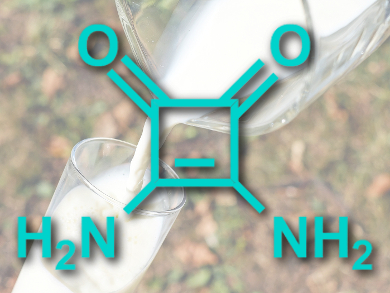Lactose is a sugar found in cow’s milk. Lactose intolerance is a common health issue. However, measuring the lactose content of milk usually requires separating the samples into individual sugars, which can be time-consuming and expensive. Simple, selective detection methods for lactose would, thus, be useful. Squaramide (pictured) and its derivatives are rigid planar molecules used as strong hydrogen-bond donors. These compounds could potentially be used to detect sugars, but they tend to self-aggregate.
Jian Wang and colleagues, Jiangsu Normal University, Xuzhou, China, have synthesized a squaramide-containing metal‐organic framework (MOF) that prevents this self-aggregation and that can be used as a luminescent sensor for selective lactose detection. The team used a solvothermal reaction between Co(NO3)2∙6H2O, the squaramide derivative 3,3’‐((3,4‐dioxocyclobut‐1‐ene‐1,2‐iyl)bis(azanediyl))dibenzoic acid, and 4,4’‐bipyridine in a mixture of solvents (N,N-dimethylacetamide, ethanol, and water) to prepare the desired MOF, a red crystalline compound with a luminescence band at 430 nm.
The researchers recorded fluorescence spectra of the MOF in the presence of different sugars and found that the MOF’s fluorescence intensity increases nearly linearly with rising lactose concentrations. The team attributes this to hydrogen-bond interactions between lactose and the squaramide derivative. The detection is highly sensitive and selective and could be used for lactose detection in milk samples.
- Squaramide-based Metal-organic Framework as Luminescent Sensor for the Detection of Lactose in Aqueous Solution and in Milk,
Min Jiang, Pingping Li, Pengyan Wu, Fengjie Zhang, Xueqing Tian, Chaofan Deng, Jian Wang,
Chem. Commun. 2018.
https://doi.org/10.1039/c8cc04723e


